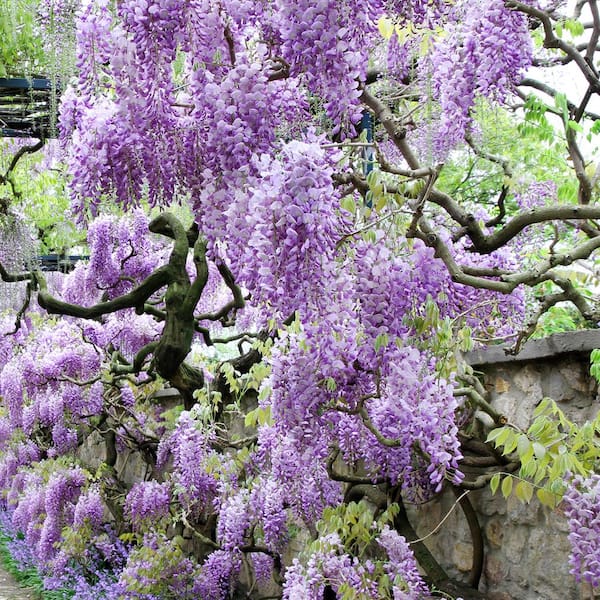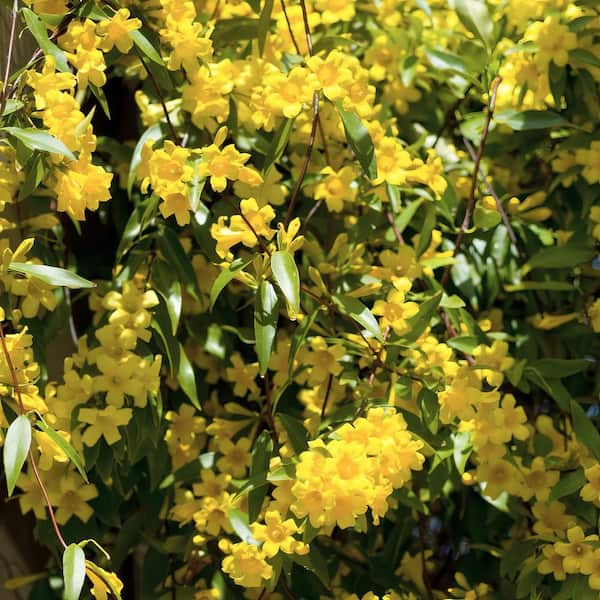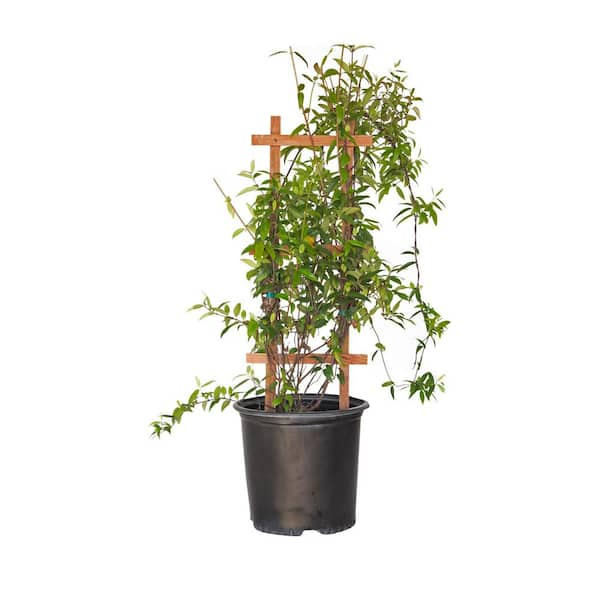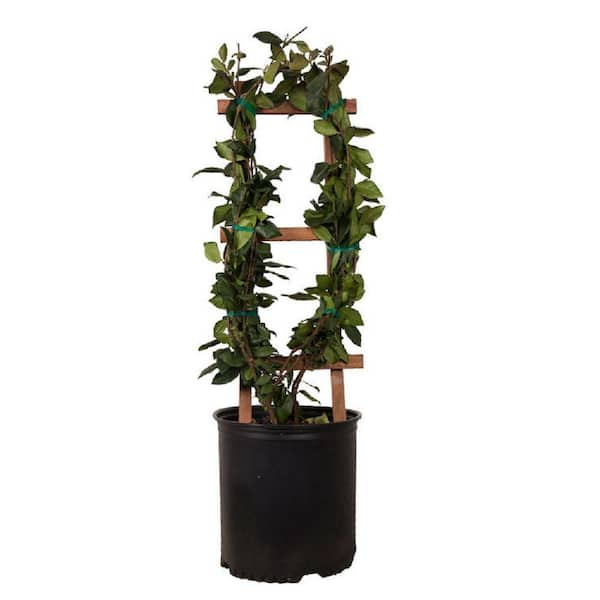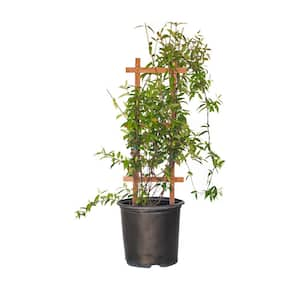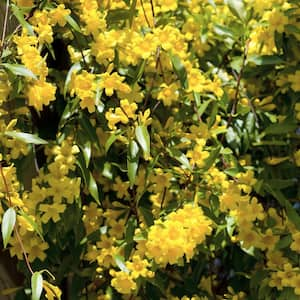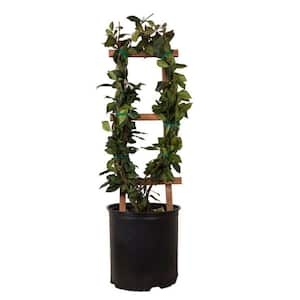
- Drought tolerant
- Vigorous grower - up to 10 ft. annually
- What we ship is 2 year old root stock, ranging 12-18 in. height
Free & Easy Returns In Store or Online
Return this item within 90 days of purchase.
Get an immediate answer with AI
AI-generated from the text of manufacturer documentation. To verify or get additional information, please contact The Home Depot customer service.
Product Details
About This Product
Wisteria, widely popular, is something between a shrub and a vine, blooming vigorously in spring with showy, cascading flower clusters that provide growing color. Wisteria provides the drapery, vining slipcover look to camouflage a view or provide shade over a porch or pergola. It can live a long, healthy life with no pruning at all (depending on the look you seek), happily twining, climbing, and sprawling over everything and anything in its path. A sturdy support is recommended. It is drought tolerant, and easy to grow by anyone, green thumb or not. Wisteria gives the artful gardener a paintbrush for which to cover the landscape canvas. It is vigorous and rewarding, growing up to 10 ft. or more annually.
Highlights
- Sweet fragrance feast for the senses
- Astonishing vigor producing hundreds of violet-blue blooms
- Lasts and grows for ever
- Plant 10 in. - 15 ft. apart, crown 1 ft. below soil level
- Vigorous and rewarding, growing up to 10 ft. or more annually
- Ships to: 48 contiguous US states, plus the District of Columbia, except DE, WI, MD, ND and IDAHO
- Shop all X-Large planter pots here.Click here to learn more."
- Return Policy
Product Information
Specifications
Dimensions
Mature Height (in.) | 720 in. | Mature Width (in.) | 60 in. |
|---|
Details
Additional Characteristics | Attracts Butterflies, Attracts Hummingbirds | Annual / Perennial | Perennial |
|---|---|---|---|
Average Shipping Height (in.) | 5 in | Best Time to Plant | Spring |
Bloom Season | Spring | Blossom Color Family | Purple |
Botanical Name | Wisteria | Common Name Family | Wisteria |
Container Size | 36 Inches | Fragrance | Fragrant |
Growth Habit | Spreading | Hardiness Zone | 7 (0 to 10 F),8 (10 to 20 F),9 (20 to 30 F) |
Recommended Space Between Plantings (in.) | 15-25 | Returnable | 90-Day |
Sun Tolerance | Full Sun | Water Requirements | Twice a week |
Wildlife Attracted | Butterflies, Hummingbirds | Wildlife Deterred | No Wildlife Deterred |
Questions & Answers
Will wisteria survive a northern nevada winter
Hardy : USDA zones 5-9
i bought two of these in the spring and planted them. it is mid July and the only growth or sign of life is at the very base of trunk where new shoots are growing. What do i do with the rest of the tree/stick that hasnt grown anything? Do i cut it down to the new shoots or let it alone? i live in Pa. i made sure it was completely covered during late frosts so it wouldnt die. im.....stumped.
I would not do anything except feed it. Let it grow.
Hello, The fact that you see growth means that they are love aswell. The root will first develop its root system, before showing much growth on top. Once roots have established you will be glad to see how fast this vine will grow.
What is the growing habit of this wisteria? Does it have a trunk, or does it just throw out vines from the ground like American wisterias do? We don't want to make the same mistake we did when we planted Blue Moon.
They grow like an American wisteria
These plants shouldn't be ordered online. There isn't any way to propogate/replant and expect them to grow.
It does have a trunk. Please see the attached photos of the recently planted Wisteria from Purple root stock.
Will it grow in a large pot?
That’s what I tried. No sign of life at all.
I planted a couple of Wisteria plants I had purchased at Home Depot (not roots - actual plants) and they are doing Amazing !!! Beautiful scented flowers - have to trim the one by my front porch back...just give them something to Climb or wrap around...
No, this plant is not recommended to be grown in a large pot.
Do Wisteria's do well in Utah?
It's hardy enough to grow in most areas in Utah.
I plan on planting in full sun, is that OK? Or should I pick a different location?
I put root care when I transplanted it and then miracle gro it werkly
Yes Wisteria likes full sun.
When can one expect to see blooms? This will be the third spring and though growth is extraordinary, there is only greenery, no blooming. :-(
Wisteria's twining fragrant vines of lavender, pink and white flowers add a graceful note to your landscape as they climb on walls, wires, trellises, pergolas, arbors and trees. Varieties that are hardy for U.S. Department of Agriculture zones 8 and 9 include Japanese wisteria (Wisteria floribunda), Kentucky wisteria (Wisteria macrostachya) and American wisteria (Wisteria frutescens). Given sufficient water and light exposure, wisteria will grow rapidly but can take up to six years to start flowering. Knowing when and what to feed your wisteria will keep it strong and healthy until the blooms burst open all at once to adorn your garden with its picturesque beauty. Nutrient Needs Potassium in the soil provides wisteria a measure of protection against diseases such as powdery mildew as well as encouraging flower bud formation. If a soil test reveals that your soil is low in potassium, adjust the levels upward by applying superphosphate, potassium sulphate or potassium bicarbonate. As a legume, wisteria is able to correct any nitrogen imbalance on its own. Therefore, feeding wisteria with high-nitrogen fertilizer can stimulate rapid, uncontrolled growth. So choose low-nitrogen nutrition for best results from your wisteria. Soil Preparation Soil preparation can ensure that your wisteria gets all the nutrients it needs to thrive. Layer compost around the base of the wisteria vines in the spring and 2 inches of mulch over that for moisture retention and weed control. Work phosphorous and bone meal into the soil to help the vines flower. Supplement in the fall with rock phosphate. Fertilizer Types The Royal Horticultural Society recommends feeding wisteria fish, blood and bone meal, following the instructions on the package as to application. Sulphate of potash, rose and flowering shrub fertilizer can also contribute to the healthy development of your wisteria vines. When to Feed Most soil amendments and fertilizer feeding should take place in the spring. When first planting wisteria, lightly fertilize about four to six weeks after planting in spring or summer. In following years, when the wisteria is well-established, fertilize in early spring and again in midsummer.
I just looked out the back door and there are blooms! They are not yet fully grown nor open but they are there and they are going to be beautiful. I am unsure why they took so long [third year including planting year] but they are there now. Thank you so much for a beautiful climbing tree/bush.
How long once planted does this root take to begin producing leaves???
Wisteria shows leaves in about 8 weeks after planting. Blooming can take up to 3 years.
I bought 2, one plant was 6 weeks, the other took 9 weeks. Hang on in there!
Viewing 1-8 of 26
Customer Reviews
3 out of 5
